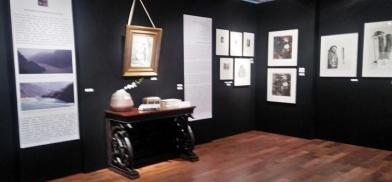India and Bangladesh artists display common cultural heritage through printmaking
Artists from India and Bangladesh displayed their printmaking creativity despite India witnessing nationwide protests against CAA, NRC. The exhibition was organised to make people aware of printmaking and to further elevate the concept and application of this medium. They also shared rich heritage through their masterpieces at India Habitat Centre, New Delhi January 23-31.

Artists from India and Bangladesh displayed their printmaking creativity despite India witnessing nationwide protests against CAA, NRC. The exhibition was organised to make people aware of printmaking and to further elevate the concept and application of this medium. They also shared rich heritage through their masterpieces at India Habitat Centre, New Delhi January 23-31.
“We know that contemporary printmaking in India and Bangladesh began in the colonial period and from the same source. We also know that how the renowned artists of these two countries have embraced the medium and practised sincerely cannot be traced to any other country in South Asia. Several artists from both countries have gained recognition and special fame in the international arena through this medium. Yet there is no denying that our ordinary people, even art connoisseur, do not show as much interest in Printmaking as they do in painting and sculpture.” says Prof. Nisar Hossain, Dean, Faculty of Fine Art, University of Dhaka.
Prof. Hossain, the curator of 'Confluence: Celebrating India-Bangladesh Printmaking', further says: “So for a long time we have felt the need to expose a comprehensive impression of our contemporary Printmaking in public. It was also thought that if we could not give the viewer an idea of the Printmaking process, they would not be able to enjoy the real essence of the medium. And that's why a team initiative of printmakers is very important. From that point of view, the first exhibition of the 65 eminent Indian artists was exhibited at the National Gallery of Bangladesh in 2018 and a permanent display corner of Indian Printmakers was established in the same gallery with donated prints of each of them.”
On the exhibition in Delhi, Prof Hossain says, “The next step in our initiative is the exhibition in Delhi. However, this exhibition has added some more important things to this event; For example, creating a folio of prints of important artists from two countries and presenting it to the collectors at as low a price as possible (such an initiative is not possible with paintings and sculptures). Apart from this, the work of two artists from two countries has been given special importance in this exhibition, who started working in this medium which was considered nearly outcast in the colonial era and has brought our printmaking art to a world-class standard with their lifelong innovation. To illustrate this point, the exhibition also showcases various stages of their work.”
In the exhibition, 'Confluence: Celebrating India-Bangladesh Printmaking,' 24 artists, 12 each from Bangladesh and India together displayed 150 prints. The artworks were chronologically arranged in the manner to portray the emergence and development of the tradition of Bangladesh and the rich heritage of India.
Artist Ananda Moy Banerji, who had pursued M.F.A in printmaking from Santiniketan, West Bengal, while explaining his artworks says, “As far as conceptual growth is concerned after the story of multiple encounters, I did the story on the series of the limbs. For me, everything is the human figure in this world because human is the main habitant, and I see even tree, seas, mountains through human forms only. “The vertical limbs or legs talk of the growth of society and horizontal limbs talk of the falling of the society. So right from the appreciation to the criticism, everything put together whether it is love, affection or rape and destruction it’s all through limbs,” says Banerji.
Co-curator Lubna Sen, founder-CEO of The Art Route, which is organizing the exhibition, says: “The purpose of this event was two-fold: First to do something for a medium called printmaking which is about a specific medium within art. Its Understanding is restricted within the artist’s community and not well known by a layperson or also some time by art lovers. In any art when understanding and appreciation is little less the patronage also goes by that at the very lower end. The art is not recognized by layman and public. The objective was to make printmaking well recognized and well-accepted concept.”
Lubna further says: “We all know that culturally India and Bangladesh are very well linked. In printmaking also the link is extremely intense and warm. There has been a lot of exchanges of ideas and thought between printmakers of these two countries through workshops, exhibitions, residency and curations. Earlier, in 2017, Multiple Encounters had organised to showcase prints of 65 Indian artists in Dhaka. This exhibition is a favour or return gift for the hospitality the artists had received there in Bangladesh. This year the theme is India and Bangladesh and next year it could be something else.”
“The spirit, intellect and harmony among the artists from both the country remained so high that there was no possibility of any kind of tension emanating from either the citizenship issue (CAA, NRC) or any other. It was very cordial and harmonious and with complete maturity,” says Lubna.
Another artist, Surender K Mishra, whose theme was on the rural and urban divide, says: “I worked on the idea of the rural-urban issue. My family migrated to Delhi in 1974 from Bihar. Migration issue was very common in the 1970s and 80s. The rural and urban divide had a great impact on my work. It is all about the conflict between rural and urban space and the issues of agrarian society in urban space. Art is a pictorial documentation of the past it can be good or bad. We just say what we feel.”
(The writer is a Delhi-based journalist)









Post a Comment